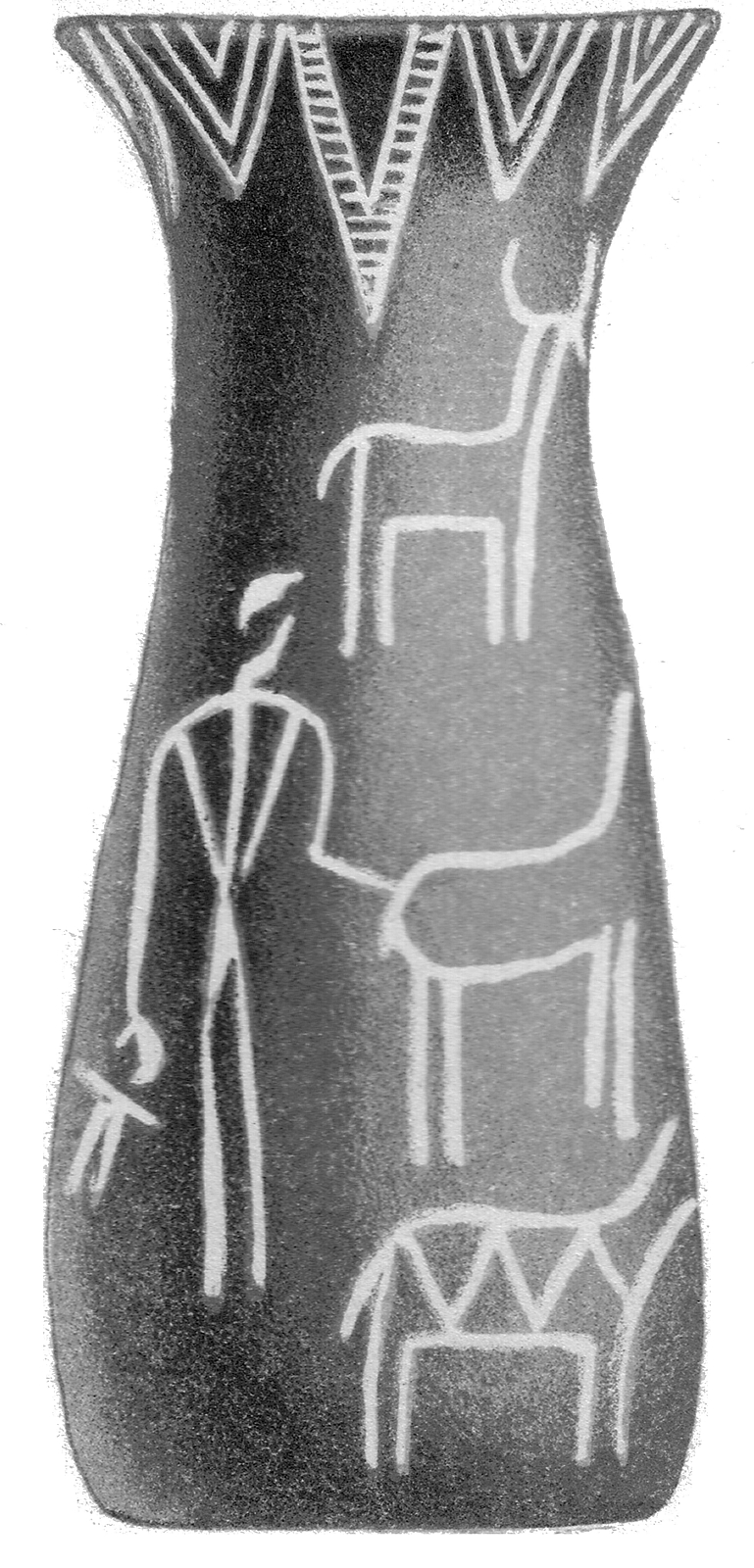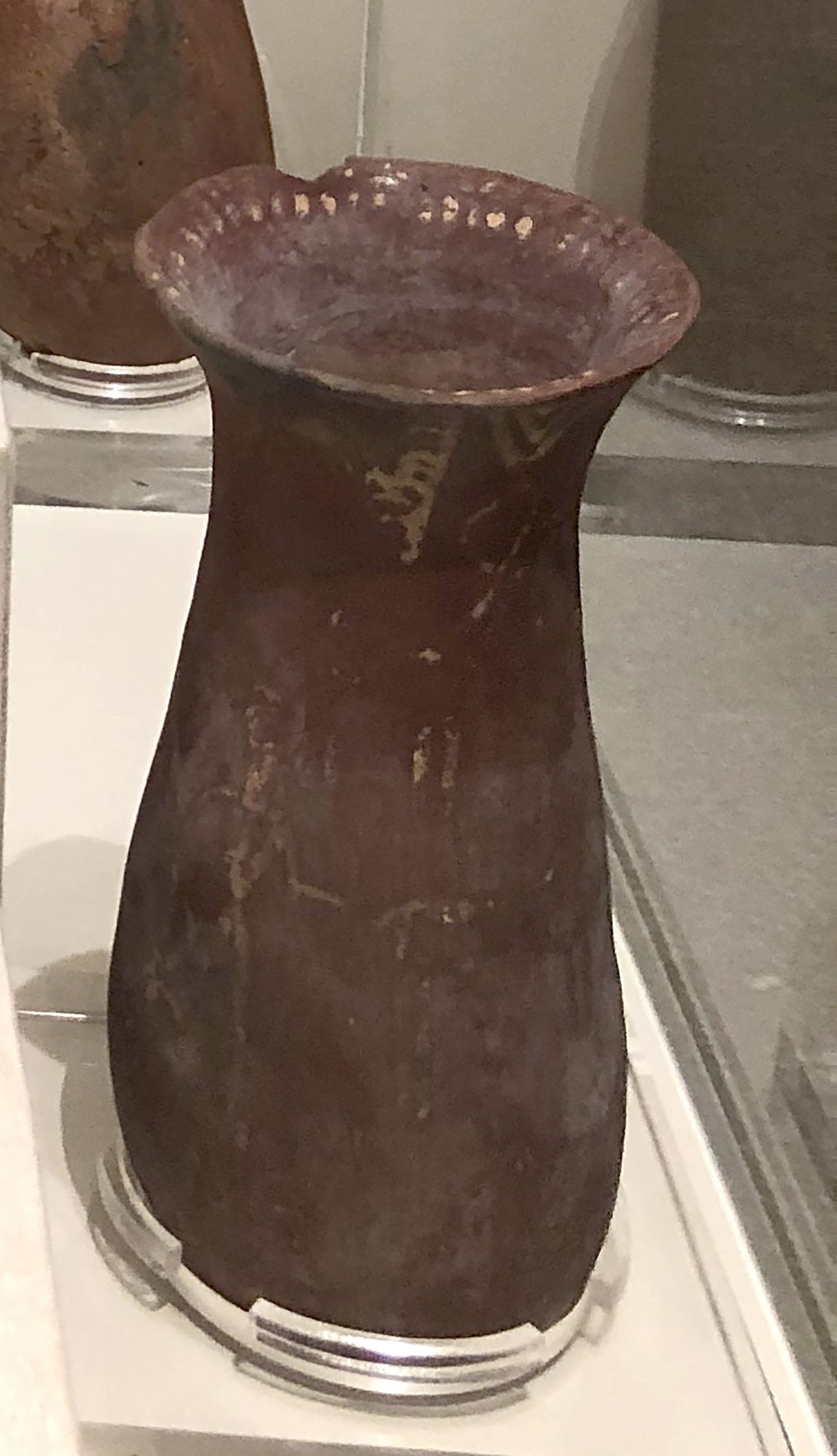C-Ware – bottle C-0101
By Droux, Xavier
, Archaeological context unknown.Cairo, National Museum of Egyptian Civilisation, CG 2077 (JE 26541).
Date : Naqada IA–IIB
General range of C-ware production
Material : Nile silt (Painted)
Preservation : Complete, repaired
Decoration preservation : Mostly faded
Decoration
Below the rim is a series of downturned triangles filled with chevrons, as well a large downturned chevron-band filled with parallel horizontal lines.
The main decorative space contains at least one standing man and several animals, possibly all cattle. All figures face toward the right, and in front of the man is are three cattle painted one above the other in a vertical series. The man's right hand is connected to the hindquarters of the cattle in the middle. Only the head of the topmost cattle is clearly visibile, and the two crescent-shaped horns that point upward indicate that a bull or a cow was intended. Only the body of the lowermost animal seems to be decorated: it is filled with a vertical zigzag.
Because the decoration has only been partially published, the motif visible next to the man's left hand has been mistakenly interpreted as an early version of an ankh-sign (Jéquier 1917), as an unidentified object held by the man (Graff 2009, sign NI7), and as a hunting trap (hendrickx, Förster, and Eyckerman 2019) when it is in fact the head of another cattle depicted behind the man.
Inside the lip is a continuous series of vertical strokes.
Dimensions (cm)
23
10.5
Additional information
Vi 46
flat base
Outside and inside lip
Comments
De Morgan (1896) indicates that the vessel comes from Gebelein; according to von Bissing (1913), it may rather come from Mohalla, located across the Nile from Gebelein. It is unclear if objects currently displayed at the National Museum of Egyptian Civlisation were given new inventory numbers.
References
1896
Recherches sur les origines de l'Egypte I: l'âge de la pierre et les métaux. Paris
, pl. III, 1.1913
Tongefässe: Erster Teil, bis zum Beginn des Alten Reiches. Catalogue Général des Antiquités Egyptiennes du Musée du Caire. Vienna
, 20, pl. 4.1917
The most ancient representation of the sign ankh. Proceedings of the Society of Biblical Archaeology 39
, 87-88.2002
Decorated sherds from renewed excavations at Locality 6, Hierakonpolis. Cahiers Caribéens d'Egyptologie 3–4
, 10, n. 18.2009
Les peintures sur vases de Nagada I–Nagada II: nouvelle approche sémiologique de l'iconographie prédynastique. Egyptian Prehistory Monographs 6. Leuven
, cat. 141.2015
De la figure anthropomorphe prédynastique à l’émergence de l’image de Pharaon: pour une approche transversale de l’imagerie pré- et protodynastique égyptienne (Nagada I-Nagada III, 3900-2700 av. J.-C.). Archéologie et Préhistoire. PHD thesis, University of Strasbourg. Strasbourg
, 1345, ref. VC_GEB_001.2019
Le taureau à l’époque prédynastique et son importance pour le développement de l’iconographie royale – avec un excursus sur l’origine du sceptre héqa, in: Aufrère, Sydney (ed.), Les taureaux de l’Égypte ancienne. Publication éditée à l’occasion de la 14e Rencontre d’égyptologie de Nîmes. Égyptonimes 2
, 41–42.
